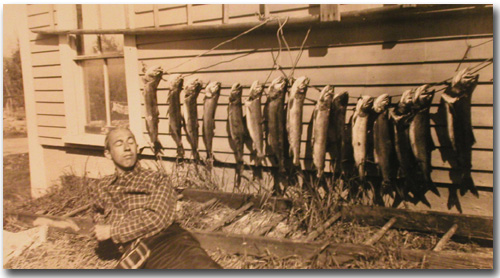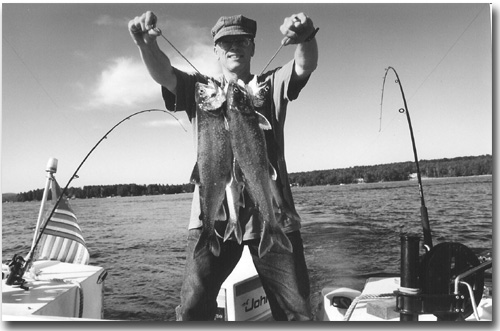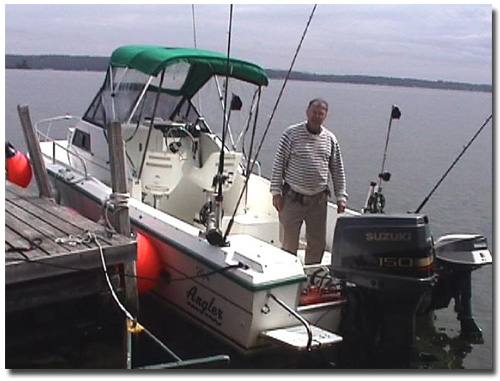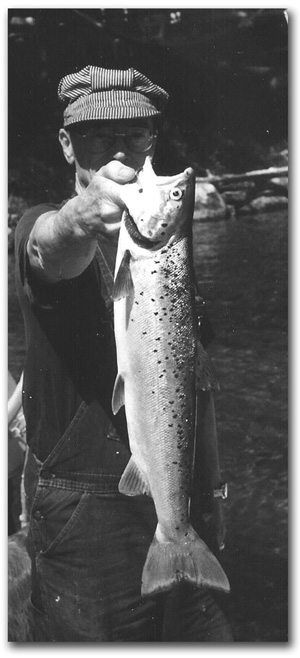Trolling For Salmon
In New Hampshire
With Master Angler Harold (Hal) C. Lyon, Jr.
70 Years Angling and Trolling for Salmon
on Lake Winni in New Hampshire
Part 1


Harold C. Lyon has an unusual background: graduate of West Point, Ranger-paratrooper officer, top posts in government: Director of Education for the Gifted, Associate Commissioner of Education for Libraries and Educational technology and project officer for "Sesame Street."
In the academic world: assistant to the president of Ohio University; the faculties of University of Massachusetts, Georgetown University, Antioch College, Dartmouth Medical School, Notre Dame College, and University in Munich, Germany.
A Fellow of the Koop Institute at Dartmouth, he is the recipient of the Gold Medal in the 1990 International Film & TV Festival of New York, a CINDY Award, and the Blue Ribbon in the 1991 American Film & Video Festival. He's the author of three other books and has been angling and trolling for salmon on Lake Winnipesaukee in New Hampshire for 70 years.
I've been fishing and trolling for salmon in Lake Winni for 70 years, beginning when I was 4, off our dock on Meredith Neck. My Uncle Gordon, who was one of the best anglers on the Lake in the 1930s-40s taught me the finer points of fishing and trolling for salmon.
My mother and I lived with her sister and Uncle Gordon and their two children, my cousins, Bill and Janet, neither of whom liked to fish, so I was fortunate to be my uncle's fishing student and he my mentor while learning trolling for salmon and other fishing methods.
This was during WWII when my father was away in Europe. My uncle taught me to fish for bass (mainly with hellgrammites and crawfish), trolling for salmon and trout, trolling with flies in spring and with heavy gear like monel wire lines and Dave Davis spinners followed by a sewed-on shiner, in the summer.
I often wonder how our fishing customs and rituals began. Is there any empirical background behind these practices?
I am reminded of this true story about the gauge of the railroad tracks, which comes from one of the railroad museums of the West in Fillmore, California:
The US standard railroad gauge (distance between the rails) is 4 feet, 8.5 inches. That's an exceedingly odd number.
Why was that gauge used?
Because that's the way they built them in England, and English expatriates built the US Railroads.
Why did the English build them like that?
Because the first rail lines were built by the same people who built the pre-railroad tramways, and that's the gauge they used.
Why did "they" use that gauge then?
Because the people who built the tramways used the same jigs and tools that they used for building wagons, which used that wheel spacing.
Okay! Why did the wagons have that particular odd wheel spacing?
Well, if they tried to use any other spacing, the wagon wheels would break on some of the old, long distance roads in England, because that's the spacing of the wheel ruts.
So who built those old rutted roads?
Imperial Rome built the first long distance roads in Europe (and England) for their legions. The roads have been used ever since.
Roman war chariots formed the initial ruts, which everyone else had to match for fear of destroying their wagon wheels. Since the chariots were made for Imperial Rome, they were all alike in the matter of wheel spacing.
The United States standard railroad gauge of 4 feet, 8.5 inches is derived from the original specifications for an Imperial Roman war chariot. And bureaucracies live forever.
So the next time you are handed a specification and wonder what horse's ass came up with it, you may be exactly right, because the Imperial Roman war chariots were made just wide enough to accommodate the back ends of two war horses.
Now the twist to the story...
When you see a space shuttle sitting on its launch pad, there are two big booster rockets attached to the sides of the main fuel tank. These are solid rocket boosters, or SRBs. The SRBs are made by Thiokol at their factory at Utah.
The engineers who designed the SRBs would have preferred to make them a bit fatter, but the SRBs had to be shipped by train from the factory to the launch site.
The railroad line from the factory happens to run through a tunnel in the mountains. The SRBs had to fit through that tunnel. The tunnel is slightly wider than the railroad track, and the railroad track, as you now know, is about as wide as two horses' behinds.
So, a major Space Shuttle design feature of what is arguably the world's most advanced transportation system was determined over two thousand years ago by the width of a horse's ass.
I'm certain some of our fishing tips and customs have a similar convoluted history!


My Uncle Gordon and my brother, Bob, who is an outdoor writer and fly fishing guide for Steelhead on the Deschutes River in Oregon. He now lives on Lopez Island off the coast of Washington State.
I also had a Great Uncle Fred Turner who was a great fisherman I did not see often. When he was with me when I was a boy, he was always teaching me about trolling for salmon and other new fishing lessons. Such as training me to cast while holding a card between my elbow and body without dropping it, to learn to use wrist action rather then my arm. He even taught me that my own earwax and the oil by the side of my nostrils were the best rod ferrule lubricants!
- What were the principal things about trolling for salmon in New Hampshire I learned from my mentors?
Patience, creativity, sportsmanship, patience, respect for the fish, patience, and fly-casting.
- What is my favorite Lake Winni game fish?
It use to be smallmouth black bass and I still believe them to be, pound for pound, the best fighting fish in the lake. But now I prefer the land-locked salmon, which are also great fighters known for their acrobatics and finicky feeding habits.
Sometimes you catch them faster than you can get your line out and other times they will not hit at all. But the bass is the most ferocious fighter. Some times I think I have an 8-pound salmon on my line…and it ends up being a 3-pound smallmouth bass.
- Which do I prefer, leadcore, fly rod, or down rigger fishing while trolling for salmon and trout?
I prefer fly-fishing on the surface in springtime when the water is cold and the salmon feed on top. There's no better thrill than a big salmon hitting my fly and fighting him with a 4-pound leader.
I catch more on leadcore than with downriggers. My theory is that the lead ball on a down rigger provides no action for the lure following it. While a lead core line, particularly on a long flexible rod which I use, bounces up and down in a rod holder, in waves. This provides a jigging motion to the lure which triggers more strikes than a stationary lure behind the lead ball of a down rigger.
I believe I have the honor of having brought to Lake Winni in 1971 the oldest down rigger on the lake, an old hand-crank Luhr Jensen which I used successfully until 2002, when I got a new boat with Big Jon downriggers. Here's a picture of me between that oldest down rigger and a not much newer Cannon.

Here's a shot of my current "angling machine" with the new electric Big Jon's.

- My favorite fishing months while trolling for salmon in New Hampshire?
May, June, July, August and September!
- Best time of day while trolling for salmon in New Hampshire?
Early morning before the sunlight pushes the plankton down, with the smelt following them, and the salmon following the smelt, to deeper waters. And I also love to fish in the evening just before dark.
- My best speed while trolling for salmon in New Hampshire?
Between 1.5-2 MPH…but I like to vary my speed.
| Chart of Fishing Depths/Colors of lead core (pound test) and best lures: |
| Month | Salmon (depth & lure) | Lakers (depth & lure) | Rainbows (depth & lure) | Bass (depth & lure) |
| April - May | On top with flies | On top with flies | On top with flies | Too early for bass |
| June | 15-20 ft. Flies, Top Gun, Sutton (G&S 61), DB Smelt | 40-50 ft. Sutton | 10-20 ft. Top Gun | Fly fishing on the beds with poppers or bassbugs |
| July | 25-40 ft. Top Gun, DB Smelt, Sutton (G&S 61) | 45-65 ft. Sutton | 20-40 ft. Top Gun | 10-20 ft. Live Hellgrammite, crawfish or live frog |
| August | 40-50 ft. Top Gun, Sutton (G&S 61), DB Smelt | 50-65 ft. Sutton | 20-40 ft. Top Gun | 10-20 ft. Live Hellgrammite, crawfish or live frog |
| September | 40-50 ft. Top Gun, Sutton (G&S 61), DB Smelt | 50-65 ft. Sutton | 20-40 ft. Top Gun | 10-20 ft. Live Hellgrammite, crawfish or live frog |
| Ice Fishing | With live smelt on tip-up fished 5 ft. off the bottom in 40-50 ft. of water |
My largest salmon, laker, rainbow, bass, and other fish:
Salmon:
Size: 5.5 pounds in spring 2003
Lure: Pumpkin Head streamer
Depth: On top
Laker:
Size: 6.5 pounds in 1976
Lure: Pearl Wobbler
Depth: 50 ft.
Rainbow:
Size: 5 pounds in summer of 2002
Lure: Silver and Red Needlefish
Depth: 40 ft.
Smallmouth Bass:
Size: 6 pounds caught September 10, 1986
Lure: Hellgrammite
I caught 2 large cusk through the ice on the same morning, one 9-pounds and one 6-pounds. Each had swallowed a smaller cusk on my line so that there was no hook in each, only a smaller 10-12" cusk wedged in the bigger ones' stomachs!
To order the complete award-winning book,
Angling in the Smile of the Great Spirit, or its accompanying DVDs featuring live interviews with the Master Anglers of Lake Winni, please go to:
www.deepwaterspress.com










